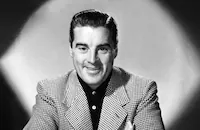She Married a Cop
Cast & Crew
Sidney Salkow
Phil Regan
Jean Parker
Jerome Cowan
Dorothea Kent
Benny Barker
Film Details
Technical Specs

Synopsis
At the New York branch of Mammoth Studios, motion picture animator Linda Fay and her boss, Bob Adams, search for a singing voice for their star cartoon, "Paddy the Pig." Linda holds auditions in her apartment, but a neighbor, disturbed by the noise, calls the police. Officers Jimmy Duffy and Joe Nash answer the call and sell Linda tickets to the policeman's ball after cautioning her to keep the noise down. As Jimmy ushers one of the singers out, he instructs him on how to sing. Linda hears his beautiful voice and eagerly awaits the ball. Linda, Bob, their pianist Sidney and secretary, Mabel Dunne, attend the ball and agree after Jimmy sings that he has the voice they need. The others then convince Linda to hire Jimmy without telling him that he is supplying the voice of a pig, but instead, letting him think that he will be a real actor. Two weeks pass as Jimmy records Paddy's songs, and he and Linda rapidly fall in love. Bob is jealous because he also loves Linda, but he realizes that there is little he can do and therefore signs Jimmy to a contract. Thrilled with the contract, Jimmy informs his family that he is quitting the police force. His parents are dismayed by his proclamation and also by his interest in Linda, whom they are afraid is too upper class for Jimmy, but their son's enthusiasm wins them over. Jimmy and Linda marry on the day of the cartoon's sneak preview, and Linda does not get a chance to tell Jimmy the truth before he sees it. All of Jimmy's family and police friends are there, and their laughter upon hearing his voice coming from the mouth of a pig wounds Jimmy to the core. That night, Joe finds Jimmy after he has gotten drunk and takes him to Linda's apartment. The next day, Jimmy bitterly accuses Linda of marrying him so that he would not break his contract, and soon after, he returns to the force. Determined to win back Jimmy, Linda moves in with his family. Jimmy counters by volunteering to work the night shift, thereby turning their schedules upside down. Bob convinces Linda to work at the studio while Jimmy is patrolling his beat, and as a week goes by, the Duffy family becomes suspicious as Linda is brought home by Bob early each morning. Meanwhile, Jimmy's cartoon is a hit and demand for a sequel grows. One afternoon, Jimmy, Linda and the family attend the policeman's picnic, and Jimmy is pleasantly surprised by the acclaim of young Paddy fans when they discover who Jimmy is. Jimmy promises Linda that they will make a fresh start, but late that night when Bob is rushing Linda home, Jimmy stops Bob's speeding car and sees his wife. Jimmy jumps to conclusions and punches Bob, after which Linda calls off their reconciliation. The next day, Jimmy's sister Trudy attempts to play peacemaker, and she sees a cartoon baby Linda has drawn with the caption "James Duffy, Jr. as I imagine him." Trudy is interviewed by reporters after she leaves Linda's apartment, and she leaks the news that Linda is pregnant. Jimmy sees the story in the newspaper and rushes to the studio, where Linda is previewing a cartoon about Paddy and his children. Jimmy is delighted that Paddy is a father, and he embraces Linda as she confirms that he is to be one too.

Director
Sidney Salkow
Cast

Phil Regan

Jean Parker

Jerome Cowan
Dorothea Kent
Benny Barker
Barnett Parker
Horace Macmahon
Oscar O'shea
Mary Gordon
Muriel Campbell

Peggy Ryan
Richard Keene
Crew
Olive Cooper
Cy Feuer
Phil Ford
Ralph Freed
Burton Lane
John Victor Mackay
Ernest Miller
Ernest Nims
Adele Palmer
Leon Schlesinger
Murray Seldeen
Sol C. Siegel
Al Wilson

Film Details
Technical Specs

Award Nominations
Best Score
Articles
Peggy Ryan (1924-2004)
Born Margaret O'Rene Ryan on August 28, 1924, in Long Beach, California, Ryan began dancing professionally as a toddler in her parents' vaudeville act, the Dancing Ryans, and was discovered by George Murphy when she was 12. Murphy arranged for young Peggy to dance with him in the Universal musical Top of the Town (1937). She would go on to make a few more film appearances over the next few years - the most striking of which as a starving, homeless girl in John Ford's The Grapes of Wrath (1940) - yet for the most part, she was hardly noticeable apart from a few dance numbers.
Her luck changed when Universal cast her opposite another teenage hoofer, Donald O'Connor in What's Cookin'? (1942). From then on, they teamed in a series of innocuous musicals that were low on production values, but high on youthful pluck. Just check out some of their titles: Private Buckaroo, Give Out, Sisters!, Get Hep to Love (all 1942); Top Man, Mr. Big (both 1943); Chip Off the Old Block, This Is the Life, and Bowery to Broadway (all 1944). They may have not been high art, but jitterbuggin' kids loved it, and given the low investment Universal put into these pictures, they turned quite the profit.
Her career slowed down after the war. In 1945, she married songwriter James Cross, and didn't return to films until 1949, when she made two minor musicals that year: Shamrock Hill, There's a Girl in My Heart. She divorced Cross in 1952 and met her second husband, dancer Ray McDonald, in her final film appearance, a forgettable musical with Mickey Rooney, All Ashore (1953). Tragically, McDonald died in 1957 after a food choking incident, and the following year, Ryan moved to Honolulu after marrying her third husband, Honolulu Advertiser columnist Eddie Sherman. She kept herself busy teaching dance classes at the University of Hawaii, but in 1969, she found herself back in front of the camera as Jenny Sherman, secretary to Detective Steve McGarrett (Jack Lord) on the long-running show Hawaii Five-O,. She played the role for seven years, remaining until 1976.
Eventually, Ryan relocated with her husband to Las Vegas, where for the last few years, she was teaching tap dancing to a whole new generation of hoofers. She is survived by her son, Shawn; daughter Kerry; and five grandchildren.
by Michael T. Toole

Peggy Ryan (1924-2004)
Quotes
Trivia
Notes
This picture's working titles were Fighting Irish and Laughing Irish Hearts. Three 1937 Hollywood Reporter news items referred to a film planned by Republic entitled Cartoon Lover and then Love's a Fable, based on an original story by Edmund Seward, which was about an animated cartoon studio and the romance of one of its cartoonists. Nancy Carroll was considering starring in the proposed film, which was to be produced by Leonard Fields. Although Edmund Seward's contribution to She Married a Cop has not been confirmed, it is possible that Republic used his basic idea for this film. Other 1937 Hollywood Reporter news items noted that Republic had purchased "Fighting Irish," an "original" story by Leo J. McCarthy, and that Sam Fuller, Ann Harolde, Dorrell McGowan, Stuart McGowan and Robert Bennett were to work on the script. Armand Schaefer was scheduled to produce at this time. The writers' contributions to She Married a Cop, however, has not been confirmed. Cy Feuer was nominated for an Academy Award in the Music (Scoring) category.

Miscellaneous Notes
Released in United States 1939
Released in United States 1939













